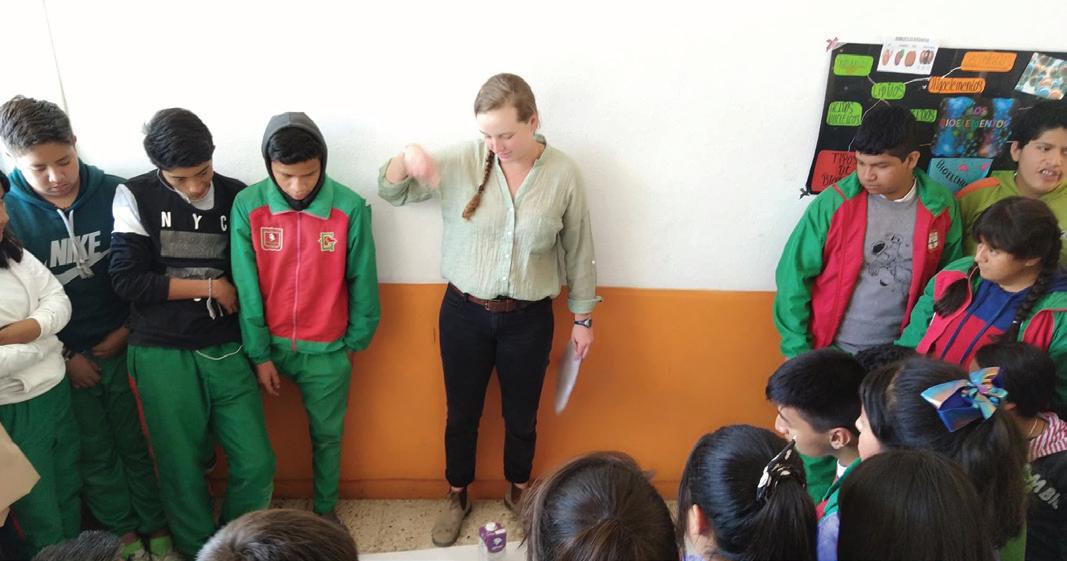
4 minute read
Daniel Wendland
Nace teaching a decomposition timeline with middle schoolers in Totolac, Mexico
social distancing. However, when I was in Mexico, I lived in a small town called San Juan Totolac, located in the state of Tlaxcala, just two hours away from Mexico City. As an environmental educator, I worked directly with the municipality’s ecology department and waste management team, developing communitywide projects for reforestation and trash management. I also worked in the elementary, middle, and high schools, teaching lessons on trash management and working with garden clubs.
Advertisement
When I wasn’t working, I spent time with my host family, learning how to cook tamales, pozole, and mole from my host mom, playing basketball with my host dad, or sharing music with my host brother. Every week in Totolac, there was something to celebrate, and, about once a week, I would find myself at a quinceañera, baptism, birthday party, or fiesta patronal, which always had plenty of delicious food and lots of cumbia dancing.
What is the best part of what you do now? The best part of serving in the Peace Corps was getting to learn so deeply about a different culture. In Mexico, mi casa es tu casa is not just a saying, it is a reality, a way of life. I am incredibly grateful to have gotten to know so many families in Mexico, all accepting me with open and warm hearts. I loved learning something every single day, whether it was going on trash routes with my counterpart Josue, learning to cook rajas con crema with my host mom, or dancing in the parade during Carnival. The atmosphere in Mexico was always filled with so much love for family and community, as well as love for enjoying the life we’re given.
What do you do for fun? For fun, I love being in nature, whether that is going on hikes, riding my bike, or just sitting on a patch of grass. In Mexico, I was lucky to be surrounded by three volcanoes (one of which was excitingly active) as well as many hills, so it was very easy to find places to recreate. I still enjoy playing sports, which was often soccer or basketball in Mexico, reading, watching a good movie, and cooking. Of course, I also love spending time and going on adventures with friends and loved ones.
TEACHER PROFILE
Daniel Wendland

Athletic Director When Daniel Wendland started at SFWS 16 years ago, he was enthusiastic, but didn’t really know what to expect. He had grown up in the California public school system, and his professional experience included working as a Movement Teacher High School Class Sponsor Photo by Dham Khalsa Photography PE teacher, a JV football and baseball coach, and as an athletic director at both public and private schools in California and Morocco. Waldorf was an entirely new system. Fortunately, it was a good fit. “Are you kidding me, it’s incredible! I love it here,” Wendland says.
Daniel was born and raised in Davis, CA, where he reveled in sports. At Davis High School, Wendland was a varsity baseball pitcher and outfielder, and through a friend, became a baseball coach at age 17 for a Little League baseball team of 8- and 9-year olds.
“I learned right then and there that I liked working with kids and that I wanted to coach,” Wendland says. He became the first in his family to go to college, ending up with a BS in Kinesiology from Humboldt State University in Arcata, CA, in 2001.
In 2002, Wendland and his then-wife moved to Morocco where he became the athletic director (AD) for the K-12 Al Akhawayn School of Ifrane, teaching Moroccan students in the all-English curriculum. He found it fascinating, but after two years, “my wife was done being a woman in a Muslim country,” Wendland notes. In Santa Fe, Wendland found an SFWS posting for a movement teacher/AD to originate the school’s athletic and movement program. Although Wendland was unfamiliar with Waldorf, he was encouraged by his former wife and mother-inlaw, who had been a Waldorf student and teacher respectively. Offered a job after a telephone interview, Wendland started here in 2004.
Part of what intrigued him about Waldorf was its flexible curriculum. Not only did Wendland create multiple competitive team programs from scratch, but he also learned to train students for unique Waldorf events like the Pentathlon. Wendland was also able to create innovative blocks such as social dance and circus arts. “I didn’t know how to juggle. I’d never been on a unicycle, I didn’t play with bean bags... I had to be a jack of all trades,” he notes.
Now married to Jayita Sahni, an architect with the State of New Mexico, the couple's two children go to SFWS: Ayesha, three, attends the preschool, and Arjun, six, will start first grade next year. To have his children go to Waldorf brings Wendland's professional and personal life full circle. He was new to Waldorf early childhood education and is inspired by what he has seen so far: “I find it so beautiful to observe what happens in early education. Our faculty is doing such incredible work with every child who is experiencing our unique Waldorf education.” 13










